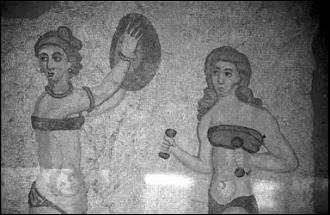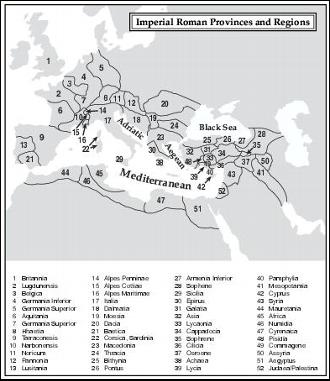The Complete Idiot's Guide to the Roman Empire (53 page)
Read The Complete Idiot's Guide to the Roman Empire Online
Authors: Eric Nelson

Â
Great Caesar's Ghost!
I can't encourage you enough, if you're interested in women's lives and history, to look into the lives of Roman women. This subject is a great deal richer and more complicated than you might think.
Their legal status improved officially little by little. In
C
.
E
. 126, Hadrian increased women's power over their personal property by loosening restrictions on their ability to make wills, and Diocletian (284â305) abolished the guardianship of women altogether. This gradual emancipation of women coincided with a decrease in the official power of the
pater familias
(the head of the family), which, judging from inscriptions and from practice, had become largely moribund long before.
However, women's personal power and autonomy rose or fell, depending on what class they belonged to. Women of the upper class exercised considerable power and independence; women of the
humiliores
mostly exercised by getting their chores done. The remains of Pompeii and the portrayal of women in the
New Testament (
Acts
) show that a great many middle-class business women were an influential sector of society. As gender roles in Christianity became entrenched, church doctrine about women provided an additional force for restricting women of all classes.
Roman women work out (note the medicine ball and “executive” dumbells) among the mosaics of the Roman villa at Piazza Armerina (Sicily), third century
C.E.

Slaves continued to remain a part of the fabric of everyday life throughout the Empire and throughout the Imperial Period. But manpower, including slave labor, became in short supply during the Empire. The slave populations were replaced in large part by poor laborers and
coloni.
Just as women achieved gradual improvement in their status, slaves received marginal, and relative, improvements under the emperors. These improvements only amounted to the right not to be castrated for profit and not to be arbitrarily killed.
As the numbers of slaves dropped, the population of freedmen did as well. As former slaves, freedmen made up a large segment of the poor, middle-class businessmen, and bureaucrats. Some, however, who were connected with the wealthy or the imperial household became fabulously wealthy and powerful during the early Empire. Under Claudius, freedmen, such as the notorious Pallas and Narcissus (see Chapter 14, “All in the Family: The Julio-Claudian Emperors”), were feared and loathed by the nobility for their personal influence, wealth, and power. But as power and wealth concentrated into fewer hands, there was also less opportunity for anyone, much less freedmen, to achieve economic and social mobility.
The army was an important factor in providing unity and cohesion to the Empire, even though it was also armies that supported generals as emperors against each other, attacked each other's provinces, and serially murdered emperors during dark periods of instability. Nevertheless soldiers, especially in the upper ranks, served commanders in campaigns all over the Empire and conceived of “Rome” as the sum of its provincial parts. Army life and culture, no matter in which province soldiers were stationed, venerated the idea of there being a
Roman
Empire and that they were
Roman
soldiers. These Joes looked forward to the rewards of an honorable discharge: a pension and
Roman
citizenship for himself, one wife, and their descendants.
Let's make like Hadrian and take an imperial survey of the Latin provinces. As we tour, we'll take a look at each area during the broad span of imperial history.
The Imperial Roman provinces and regions. After a map from the “Rome Project” of the Dalton School (
http://www.dalton.org/groups/rome/
).

North Africa had been lightly held together by Carthage, the major city in the region, but
Punic
influence never went very deep. Punic continued to be spoken in the large cities, and both Septimius Severus's and Augustine's African accent showed in their Latin. Rome, however, made the northern continent “Roman” within about 200 miles south of the coastâestimates range in the number of 200,000 settlers. The Romans were able to put their practical knowledge to good work. Aqueducts and a string of fine roads served well-founded cities and agricultural farmlands. These provinces were lost first to the Vandals, then to the Arabs, and then (depending on your politics) to the French or Islam.
Â
Roamin' the Romans
If I could get into Algeria again some day, I'd like to visit ancient Lambessa (modern Tamzult-Lambese). This city became the headquarters for the Third Legion around
C
.
E
. 129. Marcus Aurelius gave the settlement the status of a city, and Septimius Severus made it the capital of Numidia. Lambessa declined after the Romans withdrew from the area in the late fourth century, but its settlers left impressive ruins and reportedly the best preserved Roman military camp in the world.
The North African provinces were great exporters of grain, figs, and olives as well as exotic materials and animals. The emperors from Nero onward came to “inherit” huge estates there, from which they earned enormous revenues. The ruins of Leptis Magna (in Libya from which the Severan dynasty came) and those at Dougga (in Tunisia) are probably the most impressive, but many wonderful ruins await travelers throughout North Africa, if one can but get to them. Besides the Severans, many of the great early Christian writers (St. Augustine, for example) and early Christian controversies had their beginnings in North Africa.
Spain
Â
When in Rome
Punic
refers to Carthaginian culture. It comes from the Latin term for Carthaginians,
Punici
, which derived from their origin as Phonecians.
Spain was one of the earliest provinces, and certainly one of the most important, for the Roman economy, Roman literature, and Roman politics. Spanish gold, silver, copper, and other mineral mines were leased out to private concerns and provided rich returns for the state. Spanish wines, olive oil, fish products, and other natural resources were exported throughout the western Empire. The Spanish tribes, especially along the Mediterranean coast, became thoroughly Romanized and provided not only military manpower, but a host of important imperial authors (Seneca, Lucan, Quintilian, and Martial) and even emperors (Trajan and Hadrian).
Â
When in Rome
Romanitas
is the Latin term for “Roman-ness” and refers to the Roman way or manner of doing things.
Â
Roamin' the Romans
France is known for its modern chateaux, but there were many ancient Celtic/Roman examples throughout France as well. You can find one of the best preserved near Toulouse at Martres-Toulousaine. This villa, furnished with sculpture and building materials from around the time of the Empire, was unearthed only in 1826!
Spain is riddled with Roman ruins, roads, and bridges, and many of its cities have Roman roots. The extent to which Spain and Portugal achieved
romanitas
remains in its languages, which, with the exception of Basque (the Romans were only marginally better at conquering the entire Pyranees than the modern Spanish), are all Latin derivatives.
The provinces of Gaul were hard to conquer but well worth the effort for the Empire. In the north, Augusta Treverorum (Trèves) grew from a garrison colony of Claudius into the imperial capital of the western Augustus. In the northwest, Gaul remained a wild mix of Celtic and Roman elements, never really suited to the kind of urban and agricultural development upon which
romanitas
was based. Aquitania, however, with its capital Burdigala (Bordeaux) quickly became a wine producing and exporting region of estate villas. Claret has been flowing from here to the British isles for a long, long time. Inland, Lugdunium (Lyons) was a thriving imperial city and capital of Gallia Lugdunensis. And if you have ever been to Provence, you already know that you can't visit a city without seeing evidence of the thriving “more Roman than Rome” province of Gallia Narbonnensis. This province featured its own spa, Aquae Sextiae (Aix en Provence), and summer resort, Genava (Geneva).
Gaul was (and is still) served by a fine network of Roman roads and rivers for transportation, and you can see how these provinces could become their own mini-empire during the third century.
Besides wine, Gaul exported fine foods, pottery, and glass (somehow, that doesn't surprise you, does it?). At its height, about
C
.
E
. 150, greater Gaul was heavily populated, prosperous, and well-educated in Latin. Celtic was also spoken and taught, although from present-day languages one can see that only in Brittany (where a dialect of Gaelic is still spoken) and along the Rhine (where Germanic languages prevailed) did anything but Latin dialects survive.
The barbarian invasions of the next centuries brought upheaval, but in time the Frankish and Gothic invaders became the sword of the Popes, the Medieval crusaders, and emperors of the Holy Roman Empire. They were also responsible for bringing Latin back to the continent as a book language from Ireland and England, where their barbarian ancestors had helped to push it in the fifth and sixth centuries.
The Romans threw a lot of resources into Britain, but one has to wonder why. It returned little to the Empire and took a whole lot of men and money to keep. The island exported some raw materials, including famous oysters, but primarily was just able to meet its own and legionary needs. The latter was substantial. Forces required to settle and protect the lowlands, plus those required to maintain defenses at Hadrian's (and for a short time, the Antonine) Wall, made up a fair percentage of the Empire's manpower. The periodic revolts, such as those of Boudiccea (61) and Carausius (287â293), took enormous effort to suppress.
Â
Great Caesar's Ghost!
In
C
.
E
. 410, the Emperor Honorius issued a letter to Britain explaining that Alaric had sacked Rome and that the Brits were on their own. He withdrew Roman troops and commanded Britain to fend for itself against the invading Saxons. Unfortunately, the Romans had never helped the lowlands learn to organize or defend themselves, and the only people who were able to resist the Saxon invaders were the same people who had given the Romans their own troubleâthe tribes of Wales, Cornwall, and the Scottish Highlands. Everywhere else became Anglo-Saxon before the Normans arrived and altered that.
Moreover, Romanization, which to a large degree was built upon replicating Mediterranean agricultural and urban culture, simply wasn't very adaptable to British
people or climate. Urban centers were moderateâLondinium (London) reached 25,000âalthough throughout the island there were many impressive buildings and villas. The impressive spa resort of Aquae Sulis (Bath) is but one of these remains. Nevertheless, the Romans were unable to hold off the northern Picts of Scotland and the Saxons from across the channel while lands closer to Italy were being ravaged. When the Romans withdrew in 410, although the province was in a prosperous stage, they left little remaining imprint behind but for place names, ruined fortifications, and a Celtic Christianity that clung to the places that even Saxons wouldn't go.
